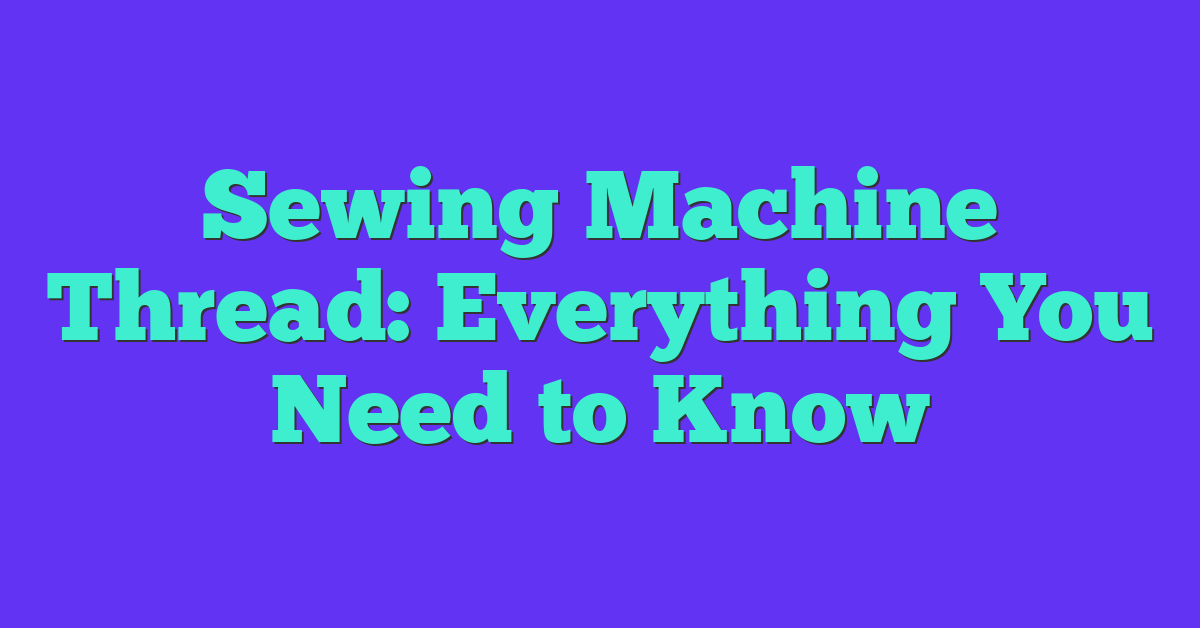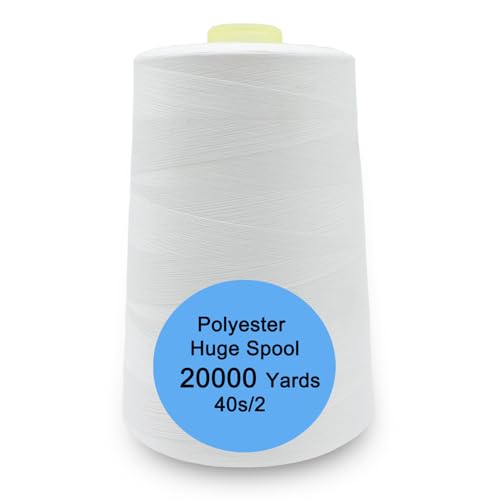Sewing machine thread is an essential component of any sewing project. It is the thread that holds the fabric together and creates the stitches that give the project its shape and design. Choosing the right thread for your project can make all the difference in the final result, and understanding the properties of different types of thread is key to making the right choice.
When it comes to selecting the right thread for your project, there are several factors to consider. Thread material, thickness, and ply all play a role in the final outcome of your project. Additionally, understanding thread tension and the role of the bobbin in threading are important for achieving the perfect stitch. Proper thread storage and maintenance can also help prolong the life of your thread and prevent tangling or breakage.
Key Takeaways
- Choosing the right sewing machine thread is important for achieving the desired outcome of your project.
- Thread material, thickness, and ply all play a role in the final result and should be considered when selecting thread.
- Proper thread storage and maintenance can help prolong the life of your thread and prevent tangling or breakage.
Understanding Sewing Machine Threads
As a sewing enthusiast, I understand the importance of choosing the right thread for a project. With so many types of threads available, it can be overwhelming to know which one to choose. In this section, I will provide an overview of the most common types of sewing machine threads and their uses.
All-Purpose Thread
All-purpose thread is the most commonly used thread for sewing. It is a good quality thread that can be used for a variety of fabrics and projects. All-purpose thread is available in both cotton and polyester materials. It is suitable for general sewing, quilting, and crafting.
Polyester Thread
Polyester thread is a strong and durable thread that is resistant to stretching and shrinking. It is a popular choice for sewing synthetic fabrics and knits. Polyester thread is available in a variety of colors and weights.
Cotton Thread
Cotton thread is a natural fiber thread that is suitable for sewing natural fabrics such as cotton, linen, and wool. It is a good quality thread that is strong and durable. Cotton thread is available in a variety of colors and weights.
Nylon Thread
Nylon thread is a strong and durable thread that is suitable for sewing heavy fabrics such as denim and leather. It is resistant to abrasion and can withstand high tension. Nylon thread is available in a variety of colors and weights.
Metallic Thread
Metallic thread is a decorative thread that adds a shiny and glittery effect to a project. It is suitable for embroidery and decorative stitching. Metallic thread is available in a variety of colors and weights.
Embroidery Thread
Embroidery thread is a decorative thread that is suitable for embroidery and decorative stitching. It is available in a variety of colors and weights. Embroidery thread is usually made of rayon or polyester materials.
Heavy Duty Thread
Heavy duty thread is a strong and durable thread that is suitable for sewing heavy fabrics and materials such as canvas, leather, and upholstery. It is available in a variety of colors and weights.
Serger Thread
Serger thread is a specialized thread that is used in sergers or overlock machines. It is available in a variety of colors and weights. Serger thread is usually made of all-purpose polyester thread.
Invisible Thread
Invisible thread is a transparent thread that is suitable for sewing hems, buttons, and zippers. It is available in a variety of weights.
Basting Thread
Basting thread is a temporary thread that is used to hold fabric in place before permanent stitching. It is available in a variety of colors and weights.
Spun Thread
Spun thread is a thread that is made by twisting together short fibers. It is a good quality thread that is suitable for general sewing and quilting.
Bonded Thread
Bonded thread is a thread that has been treated with a bonding agent to make it stronger and more durable. It is suitable for heavy-duty sewing and upholstery.
Wooly Nylon
Wooly nylon is a stretchy and soft thread that is suitable for sewing knit fabrics. It is available in a variety of colors and weights.
In conclusion, understanding the different types of sewing machine threads and their uses is essential for achieving professional-looking results in your sewing projects. By choosing the right thread for your project, you can ensure that your stitches are strong, durable, and visually appealing.

Selecting the Right Thread for Your Project
When it comes to sewing, selecting the right thread for your project is essential. The right thread can make or break your project. So, how do you choose the right thread? Here are some tips that I have learned over the years:
Consider the Project
The type of thread you choose will depend on the project you are working on. For example, if you are working on a quilting project, you will need a thread that can withstand the stress of frequent washing. On the other hand, if you are working on an upholstery project, you will need a heavy-duty thread that can withstand wear and tear.
Consider the Fabric
The type of fabric you are working with will also play a role in selecting the right thread. For example, if you are working with a delicate fabric like silk, you will need a fine thread that won’t damage the fabric. On the other hand, if you are working with a heavy fabric like denim, you will need a strong thread that can handle the weight of the fabric.
All-Purpose Thread
If you are unsure which thread to use, an all-purpose thread is a good choice. This type of thread is suitable for most fabrics and projects. It is also available in a range of colors, making it easy to match to your fabric.
Thread Weight
« Best Portable Sewing Machines for On-the-Go Sewing
Best Small Sewing Machine for Easy and Convenient Sewing »
Thread weight is another factor to consider. The weight of the thread refers to its thickness. A thicker thread is stronger, but it may not be suitable for all fabrics. On the other hand, a thinner thread may not be strong enough for some projects. Be sure to check the label on the thread to determine its weight.
Color
Finally, consider the color of the thread. You want to choose a thread that matches your fabric as closely as possible. If you can’t find an exact match, choose a thread that is slightly darker than your fabric. This will help hide any imperfections in your stitching.
In conclusion, selecting the right thread for your project is essential for a successful sewing project. Consider the project, fabric, thread weight, and color when making your selection. When in doubt, an all-purpose thread is a good choice.
Thread Materials and Their Properties
When it comes to sewing machine thread, there are a variety of materials to choose from, each with its own unique properties. In this section, I will discuss some of the most common thread materials and their characteristics.
Cotton
Cotton is a popular choice for sewing thread because it is strong, durable, and easy to work with. It is also a natural fiber, which makes it a great choice for environmentally conscious sewists. Cotton thread is available in a wide range of colors and weights, making it suitable for a variety of projects.
Polyester
Polyester thread is a synthetic thread that is known for its strength and durability. It is also resistant to shrinkage and stretching, making it a great choice for sewing projects that require a lot of wear and tear. Polyester thread is available in a variety of colors and weights, and is often used for sewing knit fabrics.
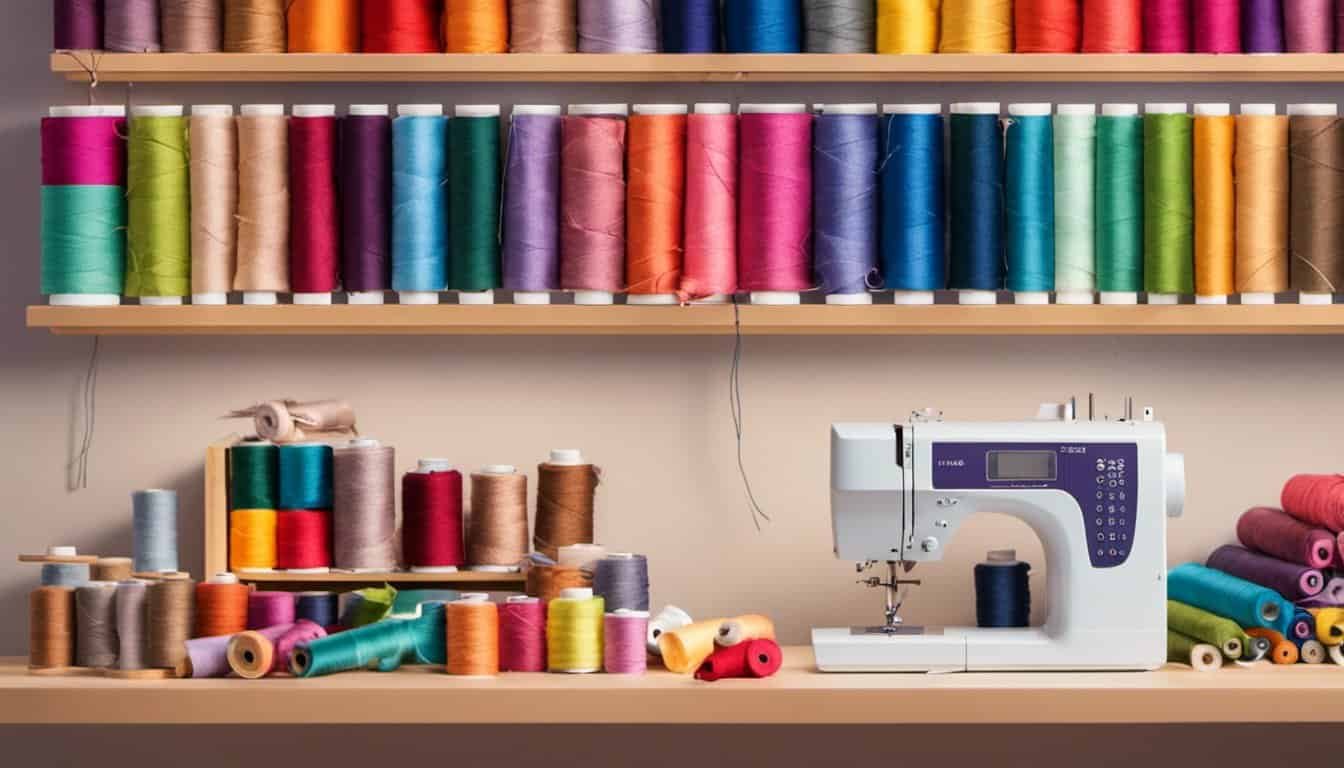
Nylon
Nylon thread is another synthetic thread that is known for its strength and durability. It is also resistant to abrasion and moisture, making it a great choice for outdoor projects. Nylon thread is available in a variety of colors and weights, and is often used for sewing leather and other heavy fabrics.
Rayon
Rayon thread is a natural fiber thread that is known for its luster and sheen. It is also very soft and lightweight, making it a great choice for delicate fabrics. Rayon thread is available in a wide range of colors and weights, and is often used for embroidery and decorative stitching.
Metallic
Metallic thread is a thread that is made with a metallic coating. It is often used for decorative stitching and embroidery, and is available in a variety of colors and weights. Metallic thread can be difficult to work with, as it can be prone to breaking and tangling.
Natural Fibers
Natural fibers such as linen and wool can also be used for sewing thread. Linen thread is known for its strength and durability, while wool thread is known for its softness and warmth. These threads are often used for specialty projects, such as historical reenactment costumes.
Synthetic
In addition to polyester and nylon, there are a variety of other synthetic threads available, including elastic shirring thread. These threads are often used for specific projects, such as sewing swimwear or lingerie.
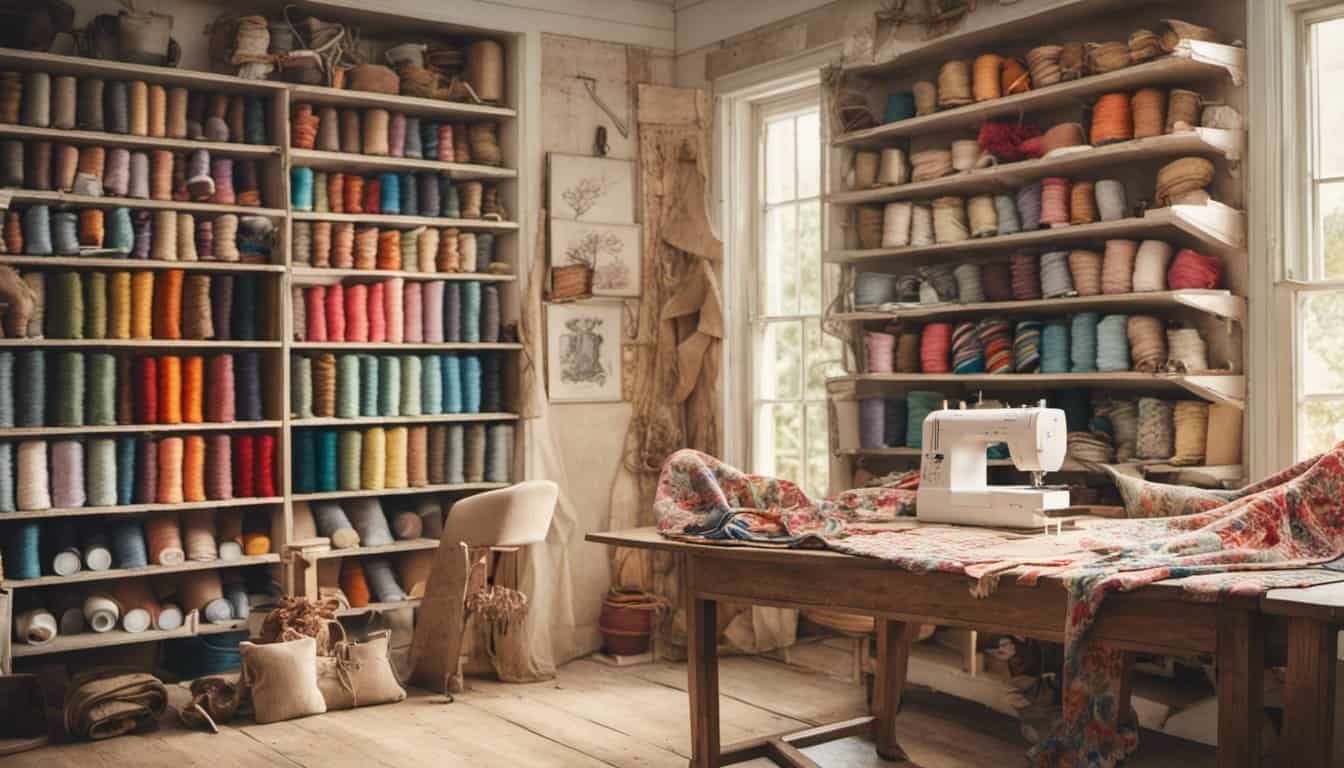
In conclusion, choosing the right thread material for your sewing project is important for achieving the best results. Each material has its own unique properties, so it is important to consider the fabric you are working with and the intended use of your project when selecting a thread.
Thread Thickness and Ply
When it comes to sewing machine thread, one of the most important factors to consider is thread thickness. Thread thickness is often measured in weight or diameter, with a higher number indicating a thicker thread.
Extra fine threads are typically used for lightweight fabrics, such as silk or chiffon. These threads are usually labeled with a weight of 50 or higher. On the other hand, thicker threads are used for heavier fabrics, such as denim or canvas. These threads are often labeled with a weight of 30 or lower.
Another factor to consider is thread ply. Ply refers to the number of strands of thread that are twisted together to create a single thread. The most common ply counts are 2, 3, 4, 6, and 9. A higher ply count usually means a stronger thread, but it can also mean a thicker thread.
For example, a 4-ply thread is usually thicker and stronger than a 2-ply thread, but it may not be suitable for all projects. A 6-ply or 9-ply thread is often used for heavy-duty projects, such as upholstery or leatherwork.
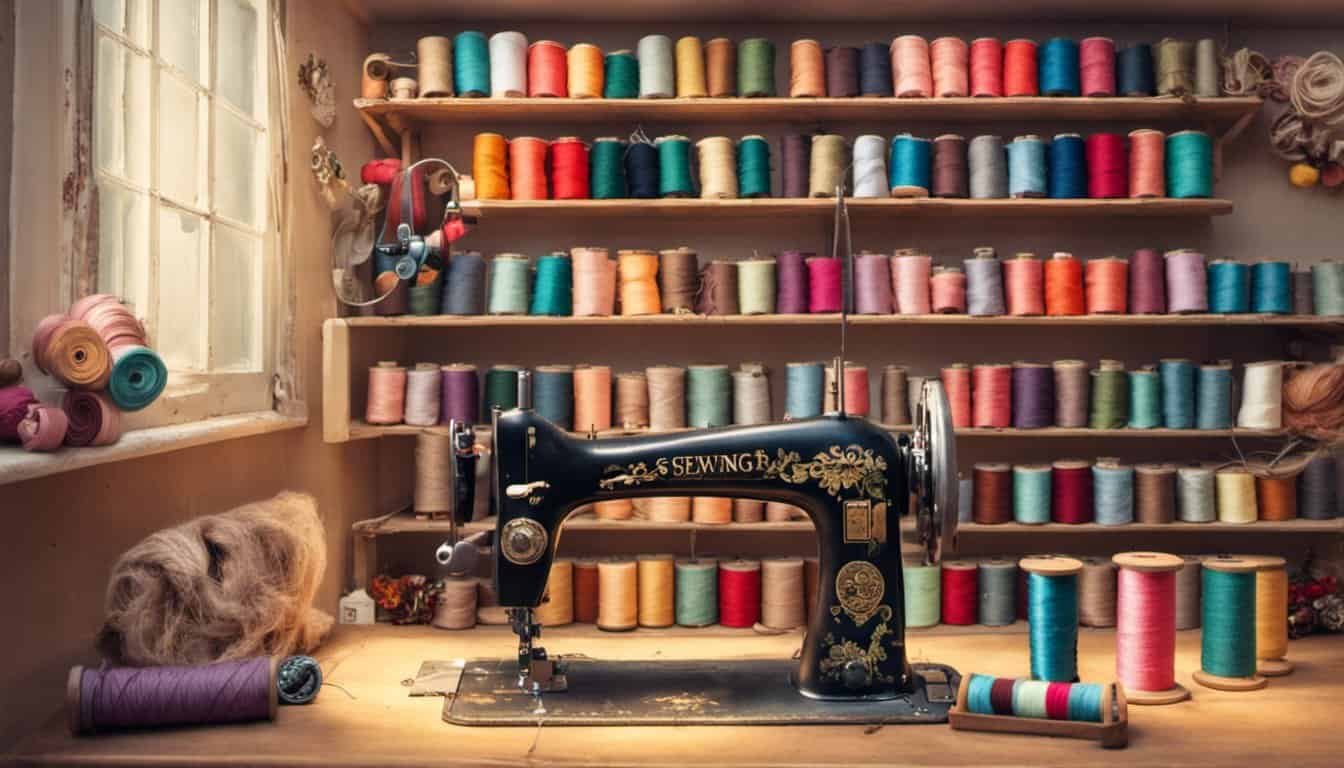
When choosing a thread for your project, it’s important to consider both the thickness and ply of the thread. A thread that is too thick or too thin may not work well with your fabric, and a thread with the wrong ply count may not be strong enough for your project.
Overall, it’s important to experiment with different thread types and sizes to find the perfect match for your project. By paying attention to thread thickness and ply, you can ensure that your sewing projects are strong, durable, and beautiful.
Understanding Thread Tension
When it comes to sewing, understanding thread tension is crucial for creating strong and even stitches. Thread tension refers to the amount of tension on the thread as it passes through the machine. Too much tension can cause the thread to break, while too little tension can result in loose, uneven stitches.
To adjust the tension on your sewing machine, you will need to locate the tension discs. These are usually located near the top of the machine, and are responsible for controlling the amount of tension on the thread. As you adjust the tension, the discs will move closer or further apart, increasing or decreasing the tension on the thread.
It is important to note that different types of fabric and thread will require different tension settings. For example, thicker fabrics may require more tension, while delicate fabrics may require less. Similarly, different types of thread may require different tension settings. It is always a good idea to test your tension settings on a scrap piece of fabric before starting your project.

To adjust the tension on your machine, start by setting the tension dial to the recommended setting for your fabric and thread. If you are unsure of the recommended setting, consult your machine’s manual or a trusted sewing resource. From there, make small adjustments to the tension until you achieve the desired stitch quality. Remember to always test your tension settings on a scrap piece of fabric before starting your project.
In summary, understanding thread tension is essential for creating strong and even stitches. Adjusting the tension on your sewing machine requires locating the tension discs and making small adjustments until you achieve the desired stitch quality. Always test your tension settings on a scrap piece of fabric before starting your project to ensure the best results.
The Role of the Bobbin in Threading
Threading a sewing machine can be a challenging task, especially for beginners. One of the most important parts of the threading process is setting up the bobbin. The bobbin is a small, circular spool that holds the thread that is used to create the bottom stitches of a sewing project. It is an essential part of the sewing machine that plays a crucial role in the stitching process.
The bobbin thread is responsible for creating the stitches on the underside of the fabric. The top thread and the bobbin thread must work together in harmony to create a perfect stitch. The bobbin thread is typically made of a thinner and more lightweight thread than the top thread. It is essential to choose the right type of thread for the bobbin to ensure that the stitching is even and balanced.
The bobbin winder is the part of the sewing machine that is used to wind the thread onto the bobbin. It is a small spindle that is located on the top of the machine, near the bobbin holder. The bobbin winder is used to create a tight and even wind on the bobbin, which is essential for creating a balanced stitch. It is important to make sure that the bobbin is wound tightly and evenly to avoid any thread jams or tangles.

In conclusion, the bobbin is an essential part of the sewing machine that plays a crucial role in the stitching process. It is responsible for creating the bottom stitches of a sewing project and must work in harmony with the top thread. The bobbin thread is typically thinner and more lightweight than the top thread, and it is essential to choose the right type of thread for the bobbin. The bobbin winder is used to create a tight and even wind on the bobbin, which is essential for creating a balanced stitch.
How to Thread a Sewing Machine
Threading a sewing machine can seem intimidating, but with a little practice, it can become second nature. Here’s how I thread my sewing machine:
First, I locate the spool pin on top of my sewing machine and place my thread spool on it. I make sure the spool is turned so that the thread will be released counter-clockwise.
Next, I look for a diagram on the top of my machine that shows the path the thread should follow. If there isn’t one, I consult my instruction manual.
I then take the thread and bring it over to the thread guide(s), usually located near the top of the machine. I make sure the thread is inserted in all thread guides.
I then look for the tension mechanism and insert the thread into it. This mechanism controls how tightly the thread is pulled through the machine and is usually located near the top of the machine.
Once the thread is in the tension mechanism, I bring it down towards the needle. I make sure the presser foot is in the upward position, which allows the thread to move freely.
I then thread the needle. To do this, I take the end of the thread and pass it through the eye of the needle. A needle threader can be used to make this easier.
Finally, I turn the hand wheel towards me to lower the needle and bring up the bobbin thread. I hold onto both threads and pull them towards the back of the machine. I’m now ready to start sewing!
Remember to consult your instruction manual for specific instructions for your sewing machine. With a little practice, threading your sewing machine will become a breeze.
Thread Storage and Maintenance
As a sewing enthusiast, I know how important it is to keep your thread organized and in good condition. Proper thread storage and maintenance can make a big difference in the quality of your sewing projects. Here are some tips that I’ve found helpful:
Thread Storage
Storing your thread properly is crucial to keeping it in good condition. Here are some things to keep in mind:

- Keep your thread spools in a cool, dry place away from direct sunlight. Exposure to sunlight can cause your thread to fade over time.
- If possible, store your thread spools upright. This will help prevent them from unraveling and getting tangled.
- Use a thread spool cap to keep your thread from unwinding. This will also help prevent dust and lint from getting into the spool.
There are many different thread storage options available, from thread racks to storage boxes. Find one that works for you and keep your thread organized and easily accessible.
Thread Maintenance
Keeping your thread in good condition is important for achieving high-quality sewing results. Here are some tips for maintaining your thread:
- Check your thread for lint and dust before using it. If you notice any buildup, use a lint roller or soft brush to remove it.
- Avoid using old or brittle thread. This can cause your thread to break while sewing and can also damage your sewing machine.
- If you notice that your thread is starting to fade, it may be time to replace it. Faded thread can affect the overall appearance of your sewing projects.
By following these tips, you can keep your thread in good condition and achieve great sewing results.
Advanced Sewing Techniques
When it comes to advanced sewing techniques, the thread you use can make all the difference. Here are some tips on how to use different types of threads to achieve professional-looking results.
Seams
When sewing seams, it’s important to choose the right thread. For stretch fabrics, use a stretch thread that will move with the fabric. For fabrics that are prone to fraying, use a core-spun thread that will hold up to the friction. And for fabrics that shrink, use a monofilament thread that won’t add bulk.
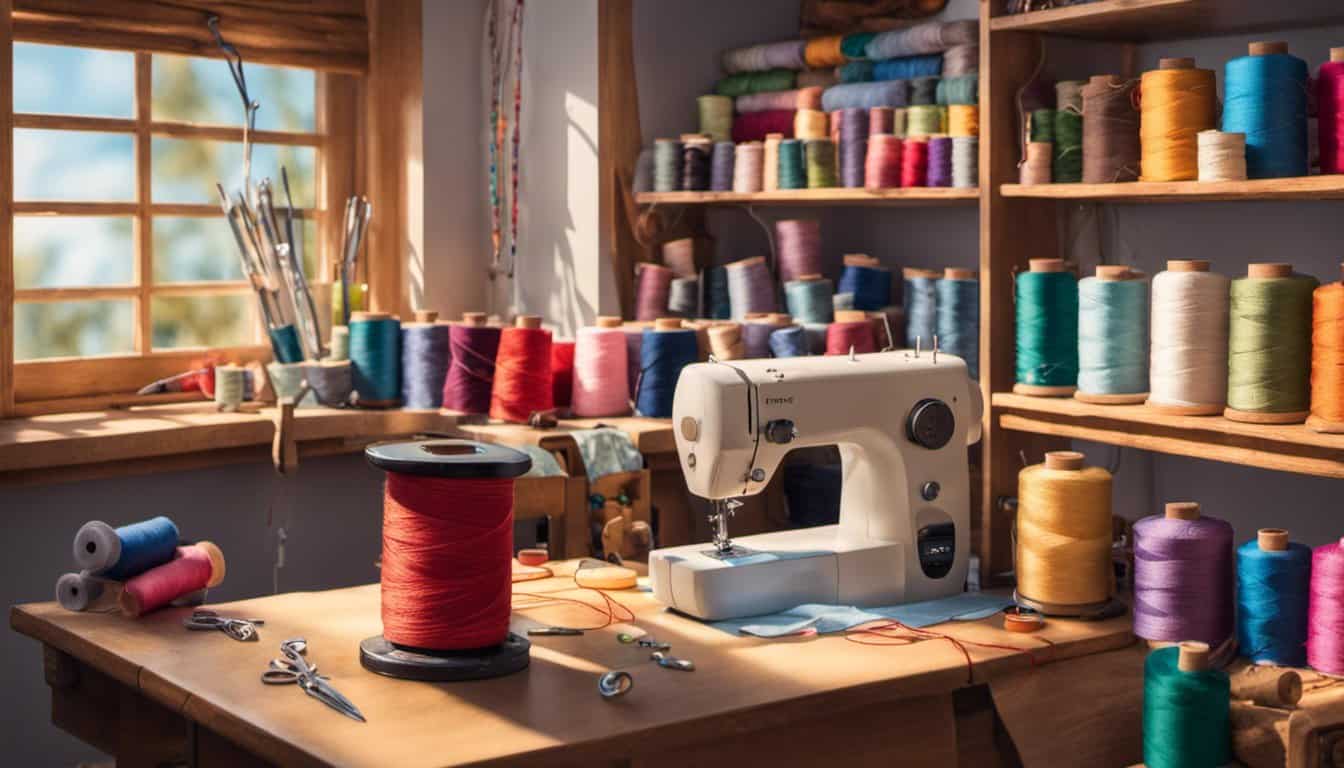
Topstitching
Topstitching is a great way to add a decorative touch to your sewing projects. To make your topstitching stand out, use a heavier weight thread in a contrasting color. For a more subtle look, use a lighter weight thread in a matching color.
Invisible Thread
Clear thread, also known as invisible thread, is a great option for finishing seams and hems. It’s also perfect for applique work and attaching trims. Just be sure to adjust your tension and use a smaller needle to prevent the thread from breaking.
Take-up Lever and Presser Foot
When using thicker threads, be sure to adjust your take-up lever and presser foot to accommodate the extra bulk. You may need to use a larger needle or adjust your tension to prevent the thread from breaking.
Plate and Filaments
When using metallic or specialty threads, be sure to use a plate with a larger hole to accommodate the filaments. You may also need to adjust your tension and use a larger needle to prevent the thread from breaking.
Finishing
To finish your sewing projects like a pro, use a cord or decorative thread to create a finished edge. You can also use a serger to finish your seams for a clean and professional look.

By using these advanced sewing techniques and experimenting with different types of threads, you can take your sewing projects to the next level.
Where to Buy Threads
When it comes to buying sewing machine threads, there are several options available. As a sewing enthusiast, I have found the following places to be great sources for threads:
Craft Stores: Craft stores are my go-to places for buying threads. Stores like Joann, Michaels, and Hobby Lobby have a wide variety of threads to choose from. They carry all-purpose threads, cotton threads, silk threads, and more. They also have different brands available, so you can choose the one that suits your needs and budget.
Online Stores: Online stores like Amazon and Wawak Sewing Supplies are also great places to buy threads. They offer a wide range of threads at competitive prices, and you can easily compare prices and brands. You can also read reviews from other customers to help you make an informed decision.
Specialty Stores: If you’re looking for specialty threads like metallic threads or embroidery threads, specialty stores are your best bet. These stores offer a wide range of threads that are not available in regular craft stores. They may be a bit pricier, but the quality is usually top-notch.
Local Sewing Shops: Local sewing shops are also great sources for threads. They usually carry high-quality threads and can offer expert advice on which threads to use for specific projects. Plus, supporting local businesses is always a good thing.
When buying threads, it’s important to consider the type of project you’re working on. Different types of threads work better for different projects, so make sure to choose the right one for your project. Also, consider the color and weight of the thread, as these factors can affect the overall look of your project.
In summary, there are several places where you can buy sewing machine threads. Craft stores, online stores, specialty stores, and local sewing shops are all great sources for threads. When buying threads, consider the type of project you’re working on and choose the right thread for your needs.
Frequently Asked Questions
What type of thread is best for a Singer sewing machine?
When it comes to choosing a thread for your Singer sewing machine, it’s important to consider the type of project you’re working on. Generally, all-purpose polyester thread will work well with most fabrics and is a good choice for beginners. However, if you’re working with delicate fabrics or heavy-duty materials like leather, you may want to consider using a specialty thread like silk or nylon. Always check your sewing machine manual for specific recommendations.

What is the difference between different types of sewing thread?
There are several types of sewing thread available, including cotton, polyester, silk, and nylon. Each type has its own unique properties that make it suitable for different types of projects. For example, cotton thread is a natural fiber that is strong and durable, making it a good choice for quilting and other heavy-duty sewing projects. Polyester thread is synthetic and has a bit of stretch, making it a good choice for knit fabrics. Silk thread is strong and smooth, making it a good choice for delicate fabrics like silk and chiffon. Nylon thread is strong and durable, making it a good choice for heavy-duty projects like upholstery and leatherwork.
What weight thread is recommended for sewing?
The weight of sewing thread refers to its thickness. The most common weight for all-purpose sewing thread is 50, but there are other weights available as well. A heavier weight thread, like 30 or 40, is good for heavy-duty projects like upholstery and leatherwork. A lighter weight thread, like 60 or 70, is good for delicate fabrics like silk and chiffon. Always check your sewing machine manual for specific recommendations.
How do I thread a sewing machine needle?
Threading a sewing machine needle can be a bit tricky, but with practice, it will become second nature. First, make sure your sewing machine is turned off. Then, raise the needle to its highest position by turning the handwheel. Next, place the spool of thread on the spool pin and thread the thread through the thread guides. Finally, thread the needle by passing the thread through the eye of the needle from front to back.
What are some recommended brands for sewing machine thread?
There are many brands of sewing machine thread available, but some of the most popular and highly recommended brands include Gutermann, Coats & Clark, and Mettler. These brands offer a wide range of thread types and colors, making it easy to find the perfect thread for your project.
Can I use polyester thread for leather sewing projects?
Yes, polyester thread can be used for leather sewing projects. However, if you’re working with thick or heavy-duty leather, you may want to consider using a specialty thread like nylon or waxed thread. These threads are stronger and more durable than polyester thread and will hold up better over time. Always check your sewing machine manual for specific recommendations.

